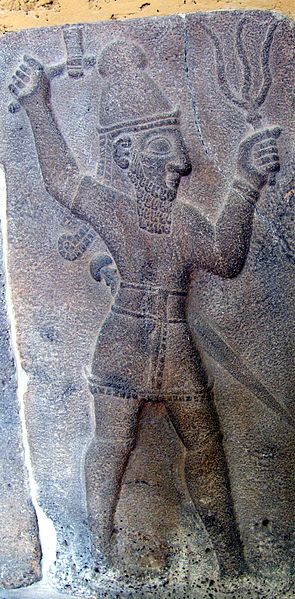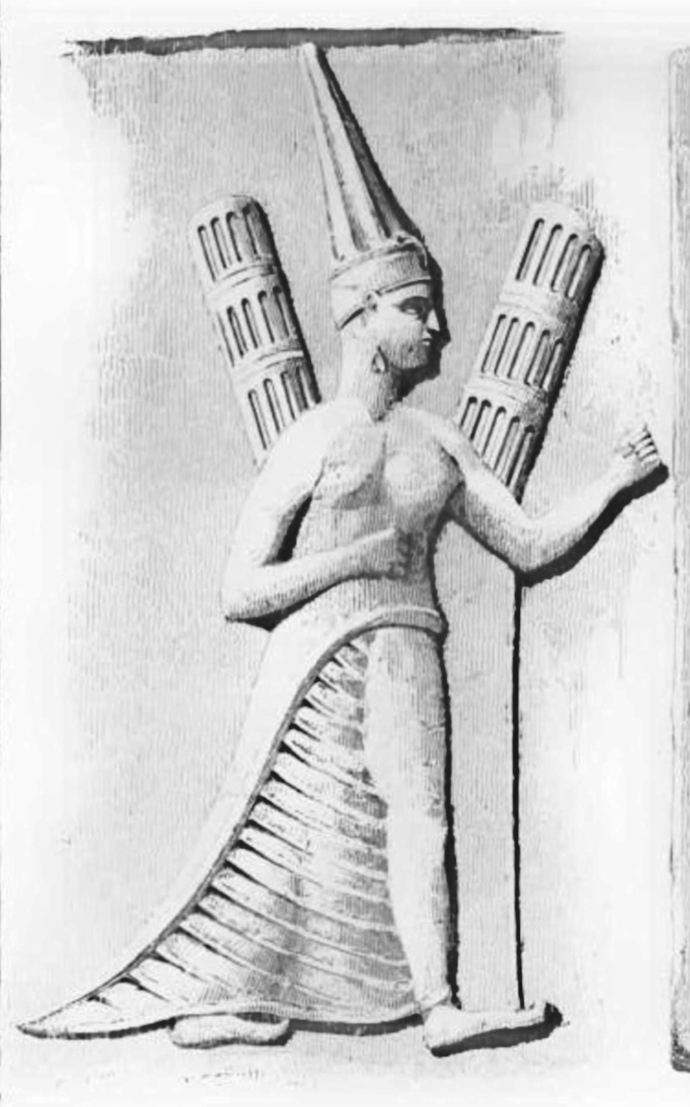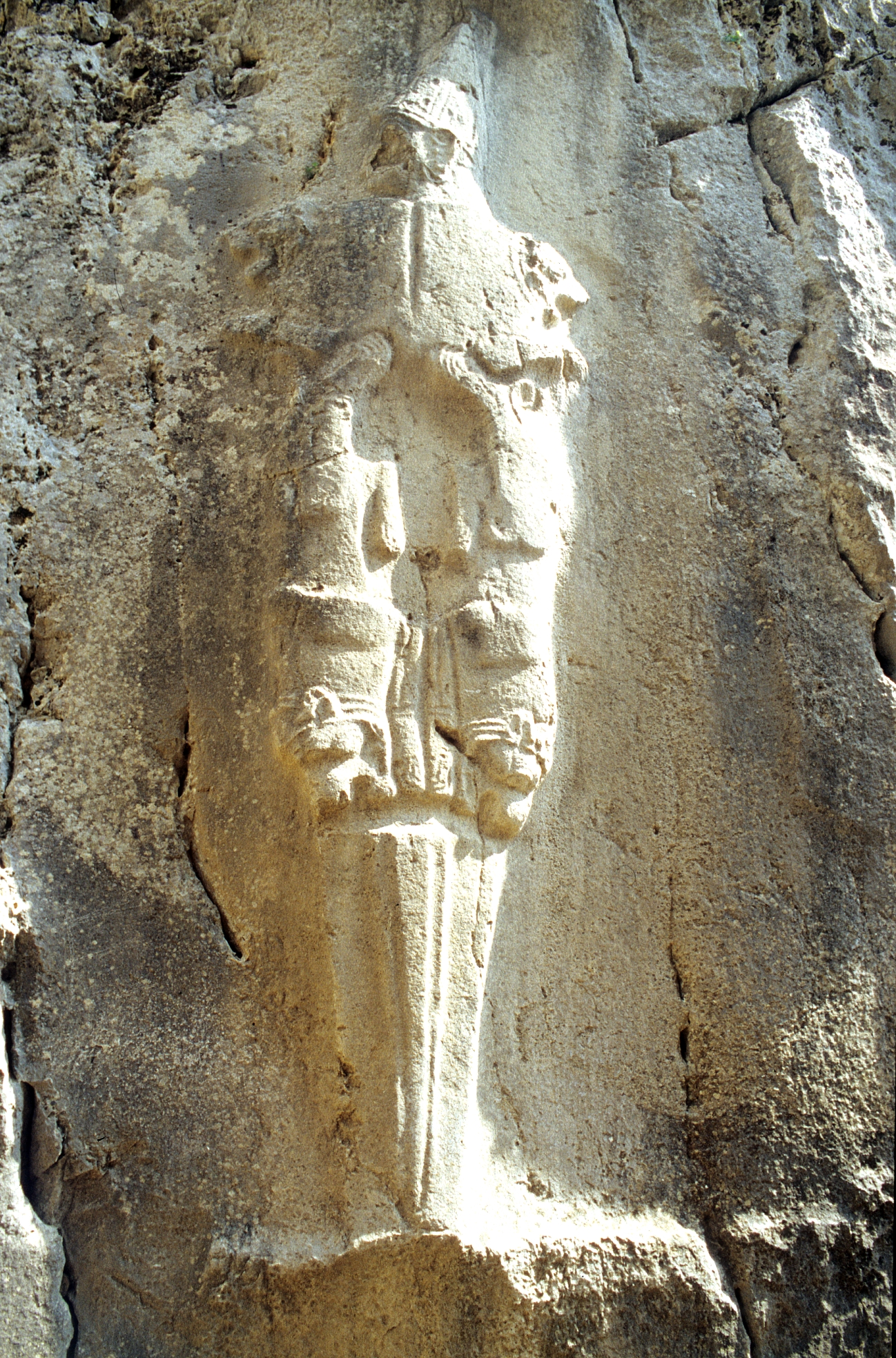|
Nupatik
Nupatik, in early sources known as Lubadag, was a Hurrian god of uncertain character. He is attested in the earliest inscriptions from Urkesh, as well as in texts from other Hurrian settlements and Ugarit. He was also incorporated into Hittite religion. A similarly named deity continued to be venerated in Erbil, Arbela as late as in the Neo-Assyrian period. Name Nupatik's name is attested for the first time in an inscription of the Hurrian king Tish-atal of Urkesh, where it is spelled syllabically as ''dingir, dlu-ba-da-ga'', rather than Sumerogram, logographically, like these of other Hurrian deities mentioned in the same text. Numerous spellings of this theonym are known, for example ''dnu-pa-ti-ik'', ''dlu-pa-ki-ta'', ''dnu-ú-pa-ti-ga'', ''dnu-pa-da-ak'', and more. He is also present in Hurrian texts from Ugarit, where his name is spelled in the local Ugaritic alphabet, alphabetic script as ''nbdg'' (𐎐𐎁𐎄𐎂). This variant of the name can be vocalized as Nubadig. Bo ... [...More Info...] [...Related Items...] OR: [Wikipedia] [Google] [Baidu] |
Hurrian Deities
The Hurrian pantheon consisted of gods of varied backgrounds, some of them natively Hurrian religion, Hurrian, while others adopted from other pantheons, for example Religion in Ebla, Eblaite and List of Mesopotamian deities, Mesopotamian. Like the other inhabitants of the Ancient Near East, Hurrians regarded their gods as anthropomorphic. They were usually represented in the form of statues holding the symbols associated with a specific deity. The Yazılıkaya sanctuary, which was Hittites, Hittite in origin but served as a center of the practice of Hurrian religion, is considered a valuable source of information about their iconography. Hurrians organized their gods into lists known as ''kaluti'' or into similar lexical lists as the Mesopotamians. The formal structure of the pantheon was most likely based on either Mesopotamian or Syrian theology. The status of individual deities and composition of the pantheon could vary between individual locations, but some can nonetheless be ... [...More Info...] [...Related Items...] OR: [Wikipedia] [Google] [Baidu] |
Hurrian God
The Hurrian pantheon consisted of gods of varied backgrounds, some of them natively Hurrian, while others adopted from other pantheons, for example Eblaite and Mesopotamian. Like the other inhabitants of the Ancient Near East, Hurrians regarded their gods as anthropomorphic. They were usually represented in the form of statues holding the symbols associated with a specific deity. The Yazılıkaya sanctuary, which was Hittite in origin but served as a center of the practice of Hurrian religion, is considered a valuable source of information about their iconography. Hurrians organized their gods into lists known as ''kaluti'' or into similar lexical lists as the Mesopotamians. The formal structure of the pantheon was most likely based on either Mesopotamian or Syrian theology. The status of individual deities and composition of the pantheon could vary between individual locations, but some can nonetheless be identified as "pan-Hurrian." The following list does not include deities ... [...More Info...] [...Related Items...] OR: [Wikipedia] [Google] [Baidu] |
Zababa
Zababa (, ''dza-ba4-ba4'', ) was a Mesopotamian god. He was the tutelary deity of the city of Kish and was regarded as a god of war. He was initially seen as a son of Enlil, though in Assyria during the reign of Sennacherib, he started to be viewed as a son of Ashur instead. The goddess Bau came to be viewed as his wife after her introduction to Kish in the Old Babylonian period. The worship of Zababa is first documented in sources from the Early Dynastic period, including texts from both Kish and other cities in Mesopotamia, for example the '' Zame Hymns'' from Abu Salabikh. His importance declined in the Sargonic and Ur III period, but he regained a more prominent position in the Old Babylonian period. Through the first millennium BCE he was worshiped both in Babylonia and in Assyria. No myths focused on Zababa are known, though he is referenced in an UD.GAL.NUN composition about the construction of Enlil's temple, in a number of legends about rulers of the Akkadia ... [...More Info...] [...Related Items...] OR: [Wikipedia] [Google] [Baidu] |
Ḫešui
Ḫešui, also known as Ḫišue, was a Hurrian religion, Hurrian war god. He was also incorporated into the Hittite mythology and religion, Hittite pantheon. He is sparsely attested in known sources, and his origin and the meaning of his name remain unknown. Origin The etymology of Ḫešui's name is unknown. Alfonso Archi argues that while it can be said with certainty that deities like Teššub and Šimige were natively Hurrian, and that others, such as Aštabi or Ḫepat were incorporated into Hurrian religion from preexisting Syria (region), Syrian pantheons (for example from among the deities worshiped in Eblaite religion), the precise origin of Ḫešui cannot be presently established. Michael C. Astour instead proposed that the alternate form ''dingir, dḪi-šu-u-e'' indicates that his name was derived from the Hurrian Root (linguistics), root ''ḫiš-'', whose meaning remains unknown. It is also attested in a personal name from Alalakh, ''Ḫi-iš-ša'', and possibly in ... [...More Info...] [...Related Items...] OR: [Wikipedia] [Google] [Baidu] |
Aštabi
Aštabi (, ''aštb''), also known as Aštabil, was a god worshiped in the third millennium BCE in Ebla, later incorporated into Hurrian beliefs in locations such as Alalakh and Ugarit and as a result also into the religion of the Hittite Empire. Name and origin The attested writings of the name are Aštabi (in Alalakh and Hattusa), Aštabil/Ašdabil (in Ebla and Mari), ''aštb'' and possibly ''`ṭtpl'' and ''`ṭtpr'' (alphabetic spellings from Ugarit). Aštabi is regarded as one of the so-called "Syrian substrate deities" by researchers. While present in the Hurrian pantheon and in earlier documents from Ebla, names of members of this group are assumed to have pre-Hurrian and most likely pre- Semitic origin. Initially Hurrian origin had been ascribed to Aštabi by researchers based on the similarity of his name to those of Kumarbi and Nabarbi, but this is no longer regarded as plausible due to the existence of earlier forms ending with -''bil'' rather than -''bi''. While ... [...More Info...] [...Related Items...] OR: [Wikipedia] [Google] [Baidu] |
Tish-atal
Tish-atal (Hurrian ) (fl. c. 21st century BC) was endan of Urkesh during the Third Dynasty of Ur. He was one of the earliest known Hurrian rulers, but the archaeological record is fragmentary for this period, and no precise date can be ascribed to his reign. Name In older literature the name ''Tishari'' is sometimes used, but it has now been established that the correct rendering is Tish-atal. Two other rulers with a similar name are known from around the same period, Tish-atal of Nineveh and Dishatal, king of Karaḫar. These are thought to be distinct persons, so the name was probably common in the area where the Hurrians lived. Inscription A cuneiform inscription about a temple of Nergal is the only source for Tish-atal. The text is found on two bronze lion statuettes, but there is a better preserved copy on a stone tablet, now in the Louvre Museum, along with one of the lions. This famous inscription is the earliest known writing in the Hurrian language. The following trans ... [...More Info...] [...Related Items...] OR: [Wikipedia] [Google] [Baidu] |
Ugur (god)
Ugur was a Mesopotamian god associated with war and death, originally regarded as an attendant deity (''sukkal'') of Nergal. After the Old Babylonian period he was replaced in this role by Ishum, and in the Middle Babylonian period his name started to function as a logogram representing Nergal. Temples dedicated to him existed in Isin and Girsu. He was also worshiped outside Mesopotamia by Hurrians and Hittites. He might also be attested in sources from Emar. Name and character Ugur's name was written in cuneiform as dU.GUR. It is alternatively romanized as Uqur or Ukur. Jeremiah Peterson notes that an Old Babylonian exemplar of the Weidner god list appears to preserve a variant spelling, dU.GU2, which supports the reading Ugur. A bilingual god list from Emar phonetically transcribes it in Hurrian as ''du-ku-ur-un''. According to Manfred Krebernik and Volkert Haas its origin and meaning are not fully certain. It has been proposed that it was the imperative form of Akkadian ''n� ... [...More Info...] [...Related Items...] OR: [Wikipedia] [Google] [Baidu] |
Hurrians
The Hurrians (; ; also called Hari, Khurrites, Hourri, Churri, Hurri) were a people who inhabited the Ancient Near East during the Bronze Age. They spoke the Hurrian language, and lived throughout northern Syria, upper Mesopotamia and southeastern Anatolia. The Hurrians were first documented in the city of Urkesh, where they built their first kingdom. Their largest and most influential Hurrian kingdom was Mitanni. The population of the Hittite Empire in Anatolia included a large population of Hurrians, and there is significant Hurrian influence in Hittite mythology. By the Early Iron Age, the Hurrians had been assimilated with other peoples. The state of Urartu later covered some of the same area. A related people to the Hurrians are the Urarteans. History Early Bronze Age The Khabur River valley became the heart of the Hurrian lands for a millennium. The first known Hurrian kingdom emerged around the city of Urkesh (modern Tell Mozan) during the third millennium BC. There ... [...More Info...] [...Related Items...] OR: [Wikipedia] [Google] [Baidu] |
Nergal
Nergal ( Sumerian: d''KIŠ.UNU'' or ; ; Aramaic: ܢܸܪܓܲܠ; ) was a Mesopotamian god worshiped through all periods of Mesopotamian history, from Early Dynastic to Neo-Babylonian times, with a few attestations indicating that his cult survived into the period of Achaemenid domination. He was primarily associated with war, death, and disease, and has been described as the "god of inflicted death". He reigned over Kur, the Mesopotamian underworld, depending on the myth either on behalf of his parents Enlil and Ninlil, or in later periods as a result of his marriage with the goddess Ereshkigal. Originally either Mammitum, a goddess possibly connected to frost, or Laṣ, sometimes assumed to be a minor medicine goddess, were regarded as his wife, though other traditions existed, too. His primary cult center was Kutha, located in the north of historical Babylonia. His main temple bore the ceremonial name E-Meslam and he was also known by the name Meslamtaea, "he who comes ... [...More Info...] [...Related Items...] OR: [Wikipedia] [Google] [Baidu] |
Wilfred G
{{disambiguation, surname ...
Wilfred may refer to: * Wilfred (given name), a given name and list of people (and fictional characters) with the name * Wilfred, Indiana, an unincorporated community in the United States * ''Wilfred'' (Australian TV series), a comedy series * ''Wilfred'' (American TV series), a remake of the Australian series * ''Wilfred'' (Thames barge) * Operation Wilfred, a British Second World War naval operation People with the surname * Harmon Wilfred, stateless businessman in New Zealand * Thomas Wilfred (1889–1968), Danish musician and inventor See also * Wilf * Wilfredo * Wilfrid ( – ), English bishop and saint * Wilfried * Wilford (other) Wilford is a village in Nottinghamshire, England. Wilford may also refer to: Places * Wilford, Arizona, a ghost town in the United States * Wilford, Idaho, an unincorporated community in the United States *Wilford, a townland in County Mayo, Ire ... [...More Info...] [...Related Items...] OR: [Wikipedia] [Google] [Baidu] |
Jean-Marie Durand
Jean-Marie Durand (; 13 November 1940) is a French Assyriologist. Career A student of the École Normale Supérieure (Lettres 1962), agrégé of grammar (1965), Doctor of History following a thesis dedicated to the documents of the rooms 134 and 160 of the Royal Palace of Mari (1975), Jean-Marie Durand was "directeur d'études" at the École pratique des hautes études (IVth section, Sumerian and Akkadian Antiques) (1987–1997) and professor at the Collège de France, holder of the chair of Assyriology (1999–2011) where he succeeded Paul Garelli. He largely devoted his research to the study of texts found in the ruins of the ancient city of Mari, and the publication of the Royal Archives of Mari. Durand was elected a member of the Académie des inscriptions et belles-lettres The () is a French learned society devoted to history, founded in February 1663 as one of the five academies of the . The academy's scope was the study of ancient inscriptions (epigraphy) and ... [...More Info...] [...Related Items...] OR: [Wikipedia] [Google] [Baidu] |
Mari, Syria
Mari (Cuneiform: , ''ma-riki'', modern Tell Hariri; ) was an ancient Semitic people, Semitic city-state in modern-day Syria. Its remains form a Tell (archaeology), tell 11 kilometers north-west of Abu Kamal on the Euphrates, Euphrates River western bank, some 120 kilometers southeast of Deir ez-Zor. It flourished as a trade center and hegemonic state between 2900 BC and 1759 BC. The city was built in the middle of the Euphrates trade routes between Sumer in the south and the Ebla, Eblaite kingdom and the Levant in the west. Mari was first abandoned in the middle of the 26th century BC but was rebuilt and became the capital of a hegemonic East Semitic languages, East Semitic state before 2500 BC. This second Mari engaged in a long war with its rival Ebla and is known for its strong affinity with Sumerian culture. It was destroyed in the 23rd century BC by the Akkadians, who allowed the city to be rebuilt and appointed a military governor (''Shakkanakku''). The ... [...More Info...] [...Related Items...] OR: [Wikipedia] [Google] [Baidu] |





